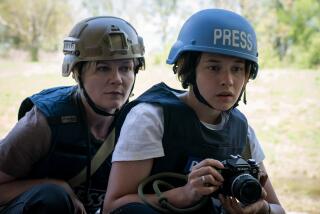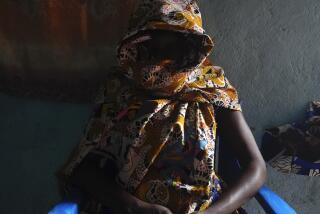Rappers Find Rhythm of War in Liberia : Africa: Tens of thousands of teen-agers are experienced veterans of the three-year civil war. They escape reality with aid of music and marijuana and have no life apart from the militias.
- Share via
NEAR KAKATA, Liberia — Even by the surreal standards of Liberia’s civil war, it was a colorful cast of characters gathered in the bush a 15-minute drive from the front line at Kakata.
There was “Lt. Col. John Garang,” for instance. Not the Sudanese rebel leader, but a speechless boy of 7 who was given the name by older fighters.
“Old” is a relative term when applied to the armed factions scrapping over Liberia. Veterans of the three-year war are often no more than 15.
“Brig. Gen.” Nixon Gay, 24, was genuinely puzzled that a foreign reporter should remark on his age.
“I been at this rank for the past two years,” Gay said as he relaxed with his boys, who are fighting for rebel leader Charles Taylor in his National Patriotic Front of Liberia (NPFL).
Gay was an austere type and sat calmly in the shade after the morning’s saber-rattling on the Kakata front, where the main enemy is another militia, called ULIMO.
But Gay’s boys had more sense of fun than their leader. Out came the jumbo marijuana cigarettes. Red eyes got redder, joking got wilder.
Entertainment was provided by two rebel rappers, a versatile duo called M. C. Ram Dee, 15, and “Col.” Mike Maclean, 16.
Like most young Liberian fighters, they can escape reality at will and pass into an imaginary world whose contours appear to be shaped by violent American films where the heroes are rapping black narcotics barons.
Col. Mike laid down the rap rhythm, a booming sound resonating through the bush and solely achieved with his mouth and his hands, the left one always covered in an oven glove, perhaps for improved percussion.
Ram Dee started up:
I am a rebel
I fought off the trouble
I took in the bubble
I said double trouble. I’m a man who’s not stable.
The boys had talent, there was no doubt about that. After a few encores the break was over and Nixon Gay shepherded his troops back on the Toyota pickup to go back to the front.
Tens of thousands of Liberian teen-agers of both sexes have no life outside the militias they have joined. It could be the NPFL, ULIMO, the Armed Forces of Liberia, the Black Berets or the latest addition, the Nimba Redemption Council.
They could be in the Small Boys battalion, the Wild Geese Dirty Dozen, the Special Strike Force.
There is no political ideology involved. Tribal affiliations may be important, but social anthropologists who could do the research are rare birds in a war zone. Favored uniforms are jeans with patches, women’s wigs and lucky charms.
Everybody is a self-designated lieutenant at the least, but a command structure does exist. For example, nobody talked back to Maj. Gen. T. Zaymay, the NPFL’s deputy army chief of staff.
“We don’t take prisoners. We solve the problem at the battlefront,” he snapped at a reporter.
Gen. Sam Varney, Charles Taylor’s “special military adviser,” stopped for a chat on the road. He got angry when asked about the patently damaging effect on the NPFL’s war effort caused by West African economic and military sanctions.
“We are guerrilla fighters. What are you talking about embargo? We don’t need fuel; we got feet to walk through the bush.”
The ebb and flow of the war is going against Taylor at the moment. But experts who follow the conflict closely fear that even if he is defeated, Liberia is set for years of gun-slinging anarchy and disintegration into fiefdoms run by warlords.
More to Read
Sign up for Essential California
The most important California stories and recommendations in your inbox every morning.
You may occasionally receive promotional content from the Los Angeles Times.













